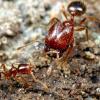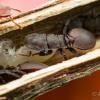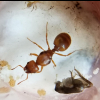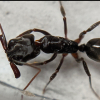- Formiculture.com
- Forums
- Gallery
- Members
- Member Map
- Chat
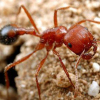
Breakthrough in the Argentine ant Problem?
Started By
Broncos
, Jul 11 2020 11:05 AM
43 replies to this topic
#1
 Offline
-
Posted July 11 2020 - 11:05 AM
Offline
-
Posted July 11 2020 - 11:05 AM
Before the quarantine, my sisters went to a park to play softball. This park only had solenopsis xyloni and Argentine ants. I wanted to do some experiments on these species. At the time I had an enormous pheidole navigans colony with 3 queens and ~1000 workers that I didn’t want anymore because they kept escaping. So one day I released them at that park and I came here 4 days a week and I would check on the ants every time. Once my pheidole colony got well into 4-5k workers they started expanding and getting closer to the Argentine ant territory. Eventually they were in each others territory and went to war for it. Luckily it was the weekend so I had been there for hours. The pheidole colony was putting the Argentine ants to shame. I had been watching this every 4 days I was at the park and at the end of the week there weren’t any Argentine ants. I checked every nest entrance I knew about and all I saw was Argentine ant brood being carried out. The tiny pheidole colony had won. This is all true. The pheidole colony is now well into the millions and almost all around the park. They took out the fire ants as well as far as I know. The Argentine ant strategy is attrition. They loose so many workers every fight but they have so much brood compared to native colonies that they win in the end. Pheidole will grow quicker and queens lay more eggs. This is why I believe they won the fight. When I get more pheidole colonies I plan on releasing them where Argentines are once they are matured. But not navigans because I know they are invasive. I plan on introducing californica. Let me know if you think it would be safe.
- TechAnt and Froggy like this
Currently Keeping:
Pogonomyrmex Californicus Bicolor & Concolor
Pogonomyrmex Subnitidius
Camponotus Sansabeanus
#2
 Offline
-
Posted July 11 2020 - 11:08 AM
Offline
-
Posted July 11 2020 - 11:08 AM
Before the quarantine, my sisters went to a park to play softball. This park only had solenopsis xyloni and Argentine ants. I wanted to do some experiments on these species. At the time I had an enormous pheidole navigans colony with 3 queens and ~1000 workers that I didn’t want anymore because they kept escaping. So one day I released them at that park and I came here 4 days a week and I would check on the ants every time. Once my pheidole colony got well into 4-5k workers they started expanding and getting closer to the Argentine ant territory. Eventually they were in each others territory and went to war for it. Luckily it was the weekend so I had been there for hours. The pheidole colony was putting the Argentine ants to shame. I had been watching this every 4 days I was at the park and at the end of the week there weren’t any Argentine ants. I checked every nest entrance I knew about and all I saw was Argentine ant brood being carried out. The tiny pheidole colony had won. This is all true. The pheidole colony is now well into the millions and almost all around the park. They took out the fire ants as well as far as I know. The Argentine ant strategy is attrition. They loose so many workers every fight but they have so much brood compared to native colonies that they win in the end. Pheidole will grow quicker and queens lay more eggs. This is why I believe they won the fight. When I get more pheidole colonies I plan on releasing them where Argentines are once they are matured. But not navigans because I know they are invasive. I plan on introducing californica. Let me know if you think it would be safe.
As somebody who keeps californica I think this would be fine. Calis can definitely compete with Argentines for turf, I don’t think they would overrun everything though.
Edited by TechAnt, July 11 2020 - 11:09 AM.
My Ants:
(x1) Campontous semitstaceus ~20 workers, 1 Queen
(x1) Camponotus vicinus ~10 workers, 1 Queen (all black variety)
(x1) Tetramorium immigrans ~100 workers, 1 Queen
(x1) Myrmercocystus mexicanus -1 Queen
(x2) Mymercocystus mimcus -1 Queen
(x1) Mymercocystus testaceus ~45 workers, 1 Queen
(x1) Campontous semitstaceus ~20 workers, 1 Queen
(x1) Camponotus vicinus ~10 workers, 1 Queen (all black variety)
(x1) Tetramorium immigrans ~100 workers, 1 Queen
(x1) Myrmercocystus mexicanus -1 Queen
(x2) Mymercocystus mimcus -1 Queen
(x1) Mymercocystus testaceus ~45 workers, 1 Queen
#3
 Offline
-
Posted July 11 2020 - 2:40 PM
Offline
-
Posted July 11 2020 - 2:40 PM
Bloody hell another one. My first response would be badly censored. So I shall say this instead, I seriously doubt that the P. navigans numbers in the millions, colony size typically runs in the hundreds . So the odds of them cleaning out the Argentines is pretty slim. As has been discussed many times release of captive colonies is frowned upon by many.
Edited by gcsnelling, July 11 2020 - 2:42 PM.
- Mdrogun likes this
#4
 Offline
-
Posted July 11 2020 - 2:42 PM
Offline
-
Posted July 11 2020 - 2:42 PM
Then there was a different pheidole species there as well. But all I see are navigans nuptial flights
Sent from my iPhone using Tapatalk
Sent from my iPhone using Tapatalk
Currently Keeping:
Pogonomyrmex Californicus Bicolor & Concolor
Pogonomyrmex Subnitidius
Camponotus Sansabeanus
#5
 Offline
-
Posted July 11 2020 - 2:50 PM
Offline
-
Posted July 11 2020 - 2:50 PM
You can go to that park if you don’t believe meBloody hell another one. My first response would be badly censored. So I shall say this instead, I seriously doubt that the P. navigans numbers in the millions, colony size typically runs in the hundreds . So the odds of them cleaning out the Argentines is pretty slim. As has been discussed many times release of captive colonies is frowned upon by many.
https://www.google.c...Q_AUoAXoECAAQBA
Sent from my iPhone using Tapatalk
Currently Keeping:
Pogonomyrmex Californicus Bicolor & Concolor
Pogonomyrmex Subnitidius
Camponotus Sansabeanus
#6
 Offline
-
Posted July 11 2020 - 2:51 PM
Offline
-
Posted July 11 2020 - 2:51 PM
Pheidole megacephala is invasive in California and does form such huge colonies, they're basically just as bad as Argentines though if not worse.
We should respect all forms of consciousness. The body is just a vessel, a mere hull.
Welcome to Lazy Tube - My Camponotus Journal
#7
 Offline
-
Posted July 11 2020 - 2:55 PM
Offline
-
Posted July 11 2020 - 2:55 PM
I don’t even know where to find thosePheidole megacephala is invasive in California and does form such huge colonies, they're basically just as bad as Argentines though if not worse.
Sent from my iPhone using Tapatalk
Currently Keeping:
Pogonomyrmex Californicus Bicolor & Concolor
Pogonomyrmex Subnitidius
Camponotus Sansabeanus
#8
 Offline
-
Posted July 11 2020 - 3:07 PM
Offline
-
Posted July 11 2020 - 3:07 PM
I say just kill as many argentines as possible. That is the best solution. Then Nylanderia can more easily get a foothold, and limit the size of argentine colonies through competition.
Hi there! I went on a 6 month or so hiatus, in part due, and in part cause of the death of my colonies.
However, I went back to the Sierras, and restarted my collection, which is now as follows:
Aphaenogaster uinta, Camponotus vicinus, Camponotus modoc, Formica cf. aserva, Formica cf. micropthalma, Formica cf. manni, Formica subpolita, Formica cf. subaenescens, Lasius americanus, Manica invidia, Pogonomyrmex salinus, Pogonomyrmex sp. 1, Solenopsis validiuscula, & Solenopsis sp. 3 (new Sierra variant).
#9
 Offline
-
Posted July 11 2020 - 3:10 PM
Offline
-
Posted July 11 2020 - 3:10 PM
Also, if Solenopsis molesta group can gain hold too, argentines stand no chance.
- RushmoreAnts likes this
Hi there! I went on a 6 month or so hiatus, in part due, and in part cause of the death of my colonies.
However, I went back to the Sierras, and restarted my collection, which is now as follows:
Aphaenogaster uinta, Camponotus vicinus, Camponotus modoc, Formica cf. aserva, Formica cf. micropthalma, Formica cf. manni, Formica subpolita, Formica cf. subaenescens, Lasius americanus, Manica invidia, Pogonomyrmex salinus, Pogonomyrmex sp. 1, Solenopsis validiuscula, & Solenopsis sp. 3 (new Sierra variant).
#10
 Offline
-
Posted July 11 2020 - 3:13 PM
Offline
-
Posted July 11 2020 - 3:13 PM
I heard winter ants can hold agains them
Sent from my iPhone using Tapatalk
But the pheidole just demolished them
Sent from my iPhone using Tapatalk
Sent from my iPhone using Tapatalk
But the pheidole just demolished them
Sent from my iPhone using Tapatalk
Currently Keeping:
Pogonomyrmex Californicus Bicolor & Concolor
Pogonomyrmex Subnitidius
Camponotus Sansabeanus
#11
 Offline
-
Posted July 11 2020 - 3:36 PM
Offline
-
Posted July 11 2020 - 3:36 PM
Bloody hell another one. My first response would be badly censored. So I shall say this instead, I seriously doubt that the P. navigans numbers in the millions, colony size typically runs in the hundreds . So the odds of them cleaning out the Argentines is pretty slim. As has been discussed many times release of captive colonies is frowned upon by many.
I agree, releasing captives is to be frowned upon by most and is a heated topic. But I don’t get the difference releasing a already native ant to a area that only has Argentines, and could hurt nothing else. But I don’t want to turn this thread into a war zone, so let’s end this here.
Yes, Winter ants do possess a liquid that repels Argentines.I heard winter ants can hold agains them
Sent from my iPhone using TapatalkBut the pheidole just demolished them
Sent from my iPhone using Tapatalk
My Ants:
(x1) Campontous semitstaceus ~20 workers, 1 Queen
(x1) Camponotus vicinus ~10 workers, 1 Queen (all black variety)
(x1) Tetramorium immigrans ~100 workers, 1 Queen
(x1) Myrmercocystus mexicanus -1 Queen
(x2) Mymercocystus mimcus -1 Queen
(x1) Mymercocystus testaceus ~45 workers, 1 Queen
(x1) Campontous semitstaceus ~20 workers, 1 Queen
(x1) Camponotus vicinus ~10 workers, 1 Queen (all black variety)
(x1) Tetramorium immigrans ~100 workers, 1 Queen
(x1) Myrmercocystus mexicanus -1 Queen
(x2) Mymercocystus mimcus -1 Queen
(x1) Mymercocystus testaceus ~45 workers, 1 Queen
#12
 Offline
-
Posted July 11 2020 - 3:43 PM
Offline
-
Posted July 11 2020 - 3:43 PM
I have seen molesta group fighting argies, not sure how it turned out. Best thing would just be to try and manage the local pops yourself.
- RushmoreAnts likes this
#13
 Offline
-
Posted July 11 2020 - 4:09 PM
Offline
-
Posted July 11 2020 - 4:09 PM
Maybe Hydroxychloroquine is the breakthrough y’all need for the Argentines?
Edited by ANTdrew, July 11 2020 - 4:10 PM.
- gcsnelling, Mettcollsuss, TennesseeAnts and 1 other like this
"The ants are a people not strong, yet they prepare their meat in the summer." Prov. 30:25
Keep ordinary ants in extraordinary ways.
Keep ordinary ants in extraordinary ways.
#14
 Offline
-
Posted July 11 2020 - 4:13 PM
Offline
-
Posted July 11 2020 - 4:13 PM
Maybe Hydroxychloroquine is the breakthrough y’all need for the Argentines?
Better yet lets inject disinfectant.
- smares likes this
#15
 Offline
-
Posted July 12 2020 - 1:30 AM
Offline
-
Posted July 12 2020 - 1:30 AM
That's going to require a lot of tiny syringes, better just throw some large piece of cotton fabric over their nests to deprive them of oxygen.
- gcsnelling, TennesseeAnts, ANTdrew and 1 other like this
We should respect all forms of consciousness. The body is just a vessel, a mere hull.
Welcome to Lazy Tube - My Camponotus Journal
#16
 Offline
-
Posted July 12 2020 - 6:30 AM
Offline
-
Posted July 12 2020 - 6:30 AM
Also, if Solenopsis molesta group can gain hold too, argentines stand no chance.
I have seen molesta group fighting argies, not sure how it turned out. Best thing would just be to try and manage the local pops yourself.
These are the best.
"God made..... all the creatures that move along the ground according to their kinds (including ants). And God saw that it was good. Genesis 1:25 NIV version
Keeping:
Tetramorium immigrans Camponotus vicinus, modoc, novaeboracensis, herculeanus
Formica pallidefulva, argentea Solenopsis molesta
Formica cf. aserva Lasius brevicornis, neoniger
#17
 Offline
-
Posted July 12 2020 - 9:35 AM
Offline
-
Posted July 12 2020 - 9:35 AM
So our yard at our beach house in NC used to have MILLIONS of Argentine ants. They lived in this tree house that our previous renters illegally put up (and we tore down). Now they only live in the trees because the ground is DOMINATED by Pheidole navigans and other Pheidole species. Insomuch that we’ve had new species come back. We now get Trachymyrmex and Dorymyrmex again. We also get dry wood termites ( the subterranean termites could hold their ground against the Argentines) We even get Camponotus sub. and Colobopsis I'm.! Overall, because the Pheidole overcame the Argentines (along with the taking down of their main nest), we barely ever see Argentines anymore and if we do it’s in our houses cause they can’t survive outside anymore from all the competition.
- TennesseeAnts and Antkid12 like this
Keeps:
1:Pogonomymex occidentalis
4: Tetramorium immigrans
2 Reticulitermes flavipes
#18
 Offline
-
Posted July 12 2020 - 10:04 AM
Offline
-
Posted July 12 2020 - 10:04 AM
So our yard at our beach house in NC used to have MILLIONS of Argentine ants. They lived in this tree house that our previous renters illegally put up (and we tore down). Now they only live in the trees because the ground is DOMINATED by Pheidole navigans and other Pheidole species. Insomuch that we’ve had new species come back. We now get Trachymyrmex and Dorymyrmex again. We also get dry wood termites ( the subterranean termites could hold their ground against the Argentines) We even get Camponotus sub. and Colobopsis I'm.! Overall, because the Pheidole overcame the Argentines (along with the taking down of their main nest), we barely ever see Argentines anymore and if we do it’s in our houses cause they can’t survive outside anymore from all the competition.
Nice!
Ants I have: Tapinoma sessile(2 queen colony). RED MORPH Camponotus neacticus(now has pupae!), Tetramorium immigrans (x3), Aphaenogaster sp, Temnothorax sp, Brachymyrmex sp. possibly infertile ![]() , Ponera pennsylvanica, and Pheidole morrisi!
, Ponera pennsylvanica, and Pheidole morrisi! ![]()
Other insects: Polistes sp. Queen
Ants I need: Pheidole sp., Trachymyrmex sp., Crematogaster cerasi , Dorymyrmex sp. Most wanted: Pheidole morrisii
#19
 Offline
-
Posted July 12 2020 - 10:05 AM
Offline
-
Posted July 12 2020 - 10:05 AM
Oohhh! Sounds so cool!So our yard at our beach house in NC used to have MILLIONS of Argentine ants. They lived in this tree house that our previous renters illegally put up (and we tore down). Now they only live in the trees because the ground is DOMINATED by Pheidole navigans and other Pheidole species. Insomuch that we’ve had new species come back. We now get Trachymyrmex and Dorymyrmex again. We also get dry wood termites ( the subterranean termites could hold their ground against the Argentines) We even get Camponotus sub. and Colobopsis I'm.! Overall, because the Pheidole overcame the Argentines (along with the taking down of their main nest), we barely ever see Argentines anymore and if we do it’s in our houses cause they can’t survive outside anymore from all the competition.
Currently Keeping:
Pogonomyrmex Californicus Bicolor & Concolor
Pogonomyrmex Subnitidius
Camponotus Sansabeanus
#20
 Offline
-
Posted July 12 2020 - 8:48 PM
Offline
-
Posted July 12 2020 - 8:48 PM
It would be wise to treat this situation in a scientific manner:
You have observed something, this is the first step in the scientific method. However you can't just draw conclusions from this observation. It would also be extremely irresponsible to attempt to alter your local ecology without express permission from the relevant government offices
Instead first form a hypothesis, an if - then statement based on your observation
Then test your hypothesis in a responsible and controlled, and most importantly repeatable manner. Do not begin randomly releasing ants in the wild because even if the ants subsequently leave, you will have no actual idea why and no one will be able to verify anything you claim in a controlled environment.
Maybe try keeping the species together in a common viviarium to see if one consistently outcompetes another, then expand on that. Eventually you may actually have proof of something and get your name in a scientific paper instead of getting a visit from the USDA for releasing ants on public property in an attempt to alter the ecology of state owned land.
You have observed something, this is the first step in the scientific method. However you can't just draw conclusions from this observation. It would also be extremely irresponsible to attempt to alter your local ecology without express permission from the relevant government offices
Instead first form a hypothesis, an if - then statement based on your observation
Then test your hypothesis in a responsible and controlled, and most importantly repeatable manner. Do not begin randomly releasing ants in the wild because even if the ants subsequently leave, you will have no actual idea why and no one will be able to verify anything you claim in a controlled environment.
Maybe try keeping the species together in a common viviarium to see if one consistently outcompetes another, then expand on that. Eventually you may actually have proof of something and get your name in a scientific paper instead of getting a visit from the USDA for releasing ants on public property in an attempt to alter the ecology of state owned land.
- hakala847 likes this
0 user(s) are reading this topic
0 members, 0 guests, 0 anonymous users


